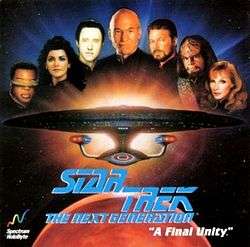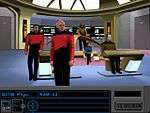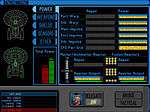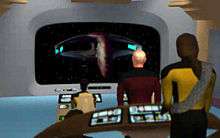Star Trek: The Next Generation – A Final Unity
| Star Trek: The Next Generation – A Final Unity | |
|---|---|
 | |
| Developer(s) | Spectrum HoloByte |
| Publisher(s) | MicroProse |
| Distributor(s) |
Paramount Pictures Viacom Consumer Products |
| Producer(s) |
Mathias Genser Meg Storey |
| Designer(s) | Mathias Genser |
| Writer(s) |
Kyle Brink Vera Chan Stephen Goldin Naren Shankar Joe Ward |
| Composer(s) | Paul Mogg |
| Platform(s) | DOS, Macintosh |
| Release date(s) | May 31, 1995 |
| Genre(s) | Adventure, Puzzle Solving |
| Mode(s) | Single player |
Star Trek: The Next Generation – A Final Unity is an adventure game by Spectrum HoloByte, based on the Star Trek universe. It puts the player in control of Captain Picard and his crew of the Enterprise D and features traditional point-and-click adventure gameplay as well as free-form space exploration, diplomatic encounters and tactical ship-to-ship combat.
The cast of Star Trek: The Next Generation reprise their roles, providing the voices of their respective characters.
Plot
While on routine patrol of the Romulan neutral zone, the Enterprise intercepts a distress signal from the crew of a Garidian scout ship, seeking asylum in Federation space. After a brief confrontation with the commander of a Garidian Warbird (similar in design to a Romulan D'deridex Warbird except white in color with a red starburst design on the nose), the crew of the scout ship is beamed aboard the Enterprise. One of the refugees mentions to Captain Picard that they are in search of the Lawgiver's legendary "Fifth Scroll", which could aid in preventing war on Garid. Picard agrees to assist them, and the crew of the Enterprise sets out in search of clues to the location of the scroll.
After searching various star systems and completing several away missions, the crew of the Enterprise realizes that the scroll points to the existence of an enormous and powerful ancient structure, known as the Unity Device, that was created by the Chodak, an unknown alien race, during the peak of their civilization.
The storyline takes place around stardate 47111.1, according to the opening sequence of the game. This would place the events of the game between the first two episodes of the seventh season of the series, "Descent" and "Liaisons". The non-canonical Chodak race reappear in the Star Trek Generations game.
Gameplay

Gameplay is mostly linear in nature, sometimes branching partially depending on choices made during various conversations.
Enterprise

On board the Enterprise, gameplay basically amounts to waiting until the ship arrives at its next destination, and occasionally conversing with various crewmembers for advice. There are various areas of the main bridge that can be interacted with to control the ship and consult with various people.
- The conference lounge allows the player to ask advice from the Garidian refugees.
- The Conn can be used to change the ship's destination and speed. When a mission begins destination and speed are set automatically, but the player has the liberty to visit bases, sectors and systems at will, though this will not affect anything in the main scenario.

- Various information on planets, alien species, and previous missions can be accessed from the Ops console, manned by Lt. Cmdr. Data.
- The tactical console is manned by Lt. Worf. Accessing it automatically brings the ship to red alert status. During the occasional battle with an enemy ship, control of the tactical console can be delegated to Lt. Worf, or controlled by the player.
The turbolift allows for access to other areas of the ship.
- From engineering, power levels can be adjusted and resources applied toward damaged systems can be designated. Control of engineering can be delegated to Lt. Cmdr. Geordi La Forge. Players can manipulate engineering to such a degree it is possible to cause a warp core breach or eject the warp core.
- In the transporter room, an away team can be assembled and an inventory chosen, though each mission has an automatically assigned away team (except on "Captain" difficulty, where the player can choose the team and equipment).
- On the holodeck, any previous cutscenes can be viewed, as well as a brief tutorial going over the various controls of the ship.
Away missions

The majority of the gameplay takes place by controlling an away team on various space stations and alien worlds, which is the pure adventure game part of the game. The away team is selected by the player and is then controlled in a point-and-click manner by selecting the desired command from the interface in the lower area of the screen. Items in the inventory can be used to interact with the environment in much the same way.
As in most adventure games, inventory items are used to solve various puzzles. The comments and responses of the characters vary depending on the combination the player chose.
Upon completion of the away mission, the team is beamed up, and the Enterprise awaits further orders or acts with the new information provided by the away mission.
Background

A Final Unity was originally penned for a release shortly after Interplay's Star Trek: 25th Anniversary. Since 25th Anniversary was released at the end of 1992, A Final Unity was scheduled to be released in 1993, but did not make the projected release date.
All eight principal actors of the TV show plus Majel Barrett, the voice of the computer, were hired to reprise their roles in voice-overs for the game.[1] A Final Unity was Spectrum HoloByte's second Star Trek video game, following the 1994 game Star Trek: The Next Generation: Future's Past.[1] Spectrum Holobyte acquired MicroProse shortly thereafter, and continued developing Star Trek games under the MicroProse name.
A Final Unity officially required a floating point coprocessor (FPU), which was unusual for DOS games at the time. It could still be played on a computer not equipped with one, but at reduced performance.
Reception
| Reception | ||||||||||
|---|---|---|---|---|---|---|---|---|---|---|
| ||||||||||
Upon release, A Final Unity was met with generally positive reviews. Andy Butcher from PC Gamer UK noted that the game "translates the atmosphere and 'feel' of The Next Generation almost perfectly" and praised the way it is structured as well as its visual presentation and sound design.[4] Computer Gaming World's Allen L. Greenberg criticized the games tactical battles as "often tedious and inconclusive", but found the away missions "extremely enjoyable" and the game's overall presentation "impressive".[2]
References
- 1 2 "The Next Generation: The Adventure Lives On...". Electronic Gaming Monthly (62). EGM Media, LLC. September 1994. p. 200.
- 1 2 Greenberg, Allen L. (September 1995). "And Finally, 'Unity'". Computer Gaming World (134). Ziff Davis LLC. pp. 148–154.
- ↑ "Star Trek: The Next Generation - A Final Unity Review". GameSpot. Retrieved 2015-02-14.
- 1 2 Butcher, Andy (June 1995). "Star Trek: The Next Generation - A Final Unity - Review". PC Gamer UK (19). Future Publishing. pp. 37–41.
External links
- Installation Patch & Guide for running a Final Unity under Windows XP at the Wayback Machine (archived April 2, 2007)
- Star Trek Gamer's review of A Final Unity
- Star Trek: The Next Generation - A Final Unity in Memory Alpha, with intensive details and descriptions of plot and characters
- Star Trek: The Next Generation – A Final Unity at MobyGames